FOCUS, Wentworth: Always remember to proofread and spellcheck
COMMENTARY, Brack: 2018 brings more House contests, but not a lot more women
IN THE SPOTLIGHT: Magnolia Plantation and Gardens
PALMETTO POEM, Peters: The Ravenel Bridge
WHAT WE LOVE: Tell us what you really love about the area
FEEDBACK: Send us your thoughts
MYSTERY PHOTO: Red brick building stands out on a sunny day
S.C. ENCYCLOPEDIA: Ferries
CALENDAR, June 4+: City seeks input on West Ashley
FOCUSFOCUS, Wentworth: Always remember to proofread and spellcheck
Editor’s note: The following is an excerpt offered by S.C. Poet Laureate and Charleston Currents contributing editor Marjory Wentworth at the May 27 graduation for Palmetto Scholars Academy in North Charleston. We thought you’d enjoy it.
By Marjory Wentworth, special to Charleston Currents | I am a poet, so you might think I’m going to talk about the knowledge that poetry can bring to the world and the inherent joys of being a writer, but I am speaking to you today from a different platform – as a mother whose three sons finished college not that long ago and as a professor who has taught college for many years. I have learned and continue to learn a great deal from my students, and I want to share some of this hard-earned knowledge with you.
Since I am a writer, I teach writing classes, as well as literature and public speaking. My students have to write a lot of essays; you too will have to write many essays at college. So, the title of my speech today is, Always Remember to Proofread and Spellcheck. These words may be familiar to you, but what does this have to do with you as you head off to college? More than you might think.
I have a policy in all my classes — that I will not grade a paper that has not been spellchecked or proofread. If a student can’t bother with that, then they certainly haven’t put much effort into their work. I tell my students to proofread everything they write – even social media posts and emails. Think about it – If you’re applying for a job or an internship and your email cover letter is filled with errors, what is the potential employer going to think? They’re going to think that you are stupid or lazy or both. Either way, they are not going to hire you.
But I really want to talk to you today about the larger meaning of putting care into your work and how this approach will help you with everything else you do in college and beyond, because the more effort you put into it the more you will get out of the entire experience. If you give 100 percent then you will be at peace with yourself and your outcomes. If, however, you don’t do your work and skip classes and stay out partying too much, you may find yourself with failing grades, you will have no one to blame but yourself.
Checking for spelling and grammar errors means that you assume you made some mistakes or that you missed something; it assumes that your paper isn’t perfect. Guess what, neither are you and that’s OK. Checking for errors means that you are being honest with yourself and taking responsibility for your actions. This requires a kind of mature self-awareness that many people lack. Keep that in mind when you do mess up, and believe me, you will mess up- Own your mistakes and rectify them when you can. Don’t blame others for your problems, unless you have been genuinely wronged. And when you can’t solve a problem – whether it’s something huge or small ASK FOR HELP.
Part of becoming an adult is realizing that it’s okay to ask for help. Your parents and teachers are there for you. We’re not psychic, so don’t assume that we know what’s going on with you. Also, please don’t be too hard on yourself. Everyone is broken. Everyone is trying to figure it out. You are not alone. You are never alone, and when you feel lonely reach out to someone you love. That’s why we have cell phones!
If there are things you want to change about yourself, now is the time. You need a lot of energy to experience college in the most productive way, so take good care of yourselves. It’s a chance to create new habits – eat healthier, take up running or another sport, learn to mediate or take a yoga class. Learn to play an instrument. Find something that has interested you, but something that wasn’t possible for you to do in high school. This is a chance for you to discover yourself and be the best that you can be. Before you know it, you’ll have jobs and families and very little opportunity to try new things; college is your time to figure out what YOU need to be successful and happy.
Your time at college is also a good time to figure out bigger problem-solving skills. Ask yourself, what is your moral compass? Things will happen to you that will test your beliefs. Sometimes people will let you down. You might experience tragedy – through no fault of your own. And you have to have some way to make sense of it. So, no matter what your background, I recommend that you have some sort of spiritual practice, some way of making sense of the world. Be prepared. Take the time to make sure your soul is OK.
The subject of the soul is the poet’s territory, but life teaches you that if your heart and soul are damaged or your moral compass is off, you will suffer more than you need to. Take care of it now. This is a different kind of learning, but sometimes it’s the one most neglected yet it may be the most important. Again, check yourself – take good care of yourself and the rest will follow.
- Have a comment? Send to: editor@charlestoncurrents.com
BRACK: 2018 brings more House contests, but not a lot more women candidates
By Andy Brack, editor and publisher | It may be the Year of the Woman in politics around the nation, but not in South Carolina – at least not in races for the S.C. House of Representatives
 In 2018, just over 20 percent of major party candidates in the 124 House races are women, according to a Statehouse Report analysis of state election data. Four years ago, there were nine fewer women candidates as 38 women (19.4 percent of candidates) ran for House seats.
In 2018, just over 20 percent of major party candidates in the 124 House races are women, according to a Statehouse Report analysis of state election data. Four years ago, there were nine fewer women candidates as 38 women (19.4 percent of candidates) ran for House seats.
College of Charleston political scientist Gibbs Knotts said he is surprised more women aren’t running for state House seats, particularly with a heightened energy by women about politics and organizing since President Trump was elected in 2016.
“South Carolina has the seventh lowest percentage of women state legislators in the country so there is certainly room for growth,” he said, noting a 2018 study by the Center for American Women in Politics at Rutgers University.
But he added that South Carolina’s traditional political culture as well as discrimination against women might be reasons more women aren’t running for the House here.
While the number of female candidates running in 2018 isn’t markedly different in House races, three things stand out:
Fewer unopposed Republicans. Four years ago, 48 Republican House candidates had no opposition in the primary or general election. This year, that number dropped almost in half to 27 unopposed candidates.
More contested GOP primaries. Fewer unopposed races, means more contested ones. In 2018, a dozen seats have GOP candidates who will face a primary or a primary plus a general election Democratic opponent. Why the change? More than likely, it’s because more conservative candidates emboldened by Trump are trying to drain the Statehouse swamp of already-conservative GOP House incumbents.
More contested races in November. The dynamics of politics this year reveal there will be fewer seats – 77 – decided before the general election, compared to three quarters of seats in 2014. That means voters have more choices in November. But it’s still a little disturbing that more than half of the seats don’t face general election competition, an indicator of gerrymandering at play.
“There’s a lot of interest in politics right now, thanks to Trump and some divisions within the Republican Party nationally and locally about the direction the party should go,” said Danielle Vinson, a political scientist at Furman University. “ Some of those pre-date Trump, but he has certainly exacerbated them. So, that may be driving some of the increased interest in running for office among Republicans and would explain the increase in the number of Republican incumbents facing primary challenges.”
She thought, however, some incumbents just seem to attract primary challengers, regardless of the political environment, or because they’re relatively new in office, which may draw challengers who smell weakness or opportunity.
“We learned in 2016 that incumbents can be vulnerable in primaries in South Carolina if they’ve taken controversial votes or missed a lot of votes,” Vinson said. “We lost a lot of incumbents that year.”
Knotts made a similar observation: “I suspect incumbents are being ‘primaried’ by more conservative candidates. There is probably a Trump effect taking place and there could be some backlash against the corruption probe in Columbia and the increased gas tax that was passed in 2017.”
If you’re a little miffed that 62 percent of House seats will be decided before the general election by members of one major party or the other, there are at least two options:
Run for office. The more people who run give more choices to voters, particularly in primaries. If the major parties disgust you, there are always third parties. Unfortunately, they currently fare so poorly that the state has no third-party elected officials.
Attack gerrymandering. The General Assembly will decide how House, Senate and congressional seats are drawn after the 2020 Census. If you want districts to be more competitive and reflective of how politics are in your area, you need to work or donate to organizations that want to defeat or alter the good-old-boy way districts are drawn.
Democracy is stronger when it is competitive. What we’re generally doing now is just protecting incumbents and encouraging the edges of politics, not promoting the common good.
- Have a comment? Send to: editor@charlestoncurrents.com
SPOTLIGHT: Magnolia Plantation and Gardens
 The public spiritedness of our underwriters allows us to bring Charleston Currents to you at no cost. Today we shine our spotlight on Magnolia Plantation and Gardens, founded in 1676 by the Drayton family. It has survived the centuries and witnessed the history of our nation unfold before it from the American Revolution through the Civil War and beyond. It is the oldest public tourist site in the Lowcountry and the oldest public gardens in America, opening its doors to visitors in 1870. Open 365 days a year, Magnolia offers its visitors splendid tours of nature and history and the role African-Americans played in the development of its award-winning Romantic-style gardens.
The public spiritedness of our underwriters allows us to bring Charleston Currents to you at no cost. Today we shine our spotlight on Magnolia Plantation and Gardens, founded in 1676 by the Drayton family. It has survived the centuries and witnessed the history of our nation unfold before it from the American Revolution through the Civil War and beyond. It is the oldest public tourist site in the Lowcountry and the oldest public gardens in America, opening its doors to visitors in 1870. Open 365 days a year, Magnolia offers its visitors splendid tours of nature and history and the role African-Americans played in the development of its award-winning Romantic-style gardens.
- Visit magnoliaplantation.comto learn how you can experience a complete plantation experience.
- Click here to learn about events and what’s new.
POEM, Peters: The Ravenel Bridge
By Carol Peters, special to Charleston Currents
brings an instant gush of
happiness, this measure of wanting
to live, feeling joy surge at the sight of
a steel bridge, not a shape of nature
like a heron launching into flight
or a pelican sinking like a hull into a wave —
two silver peaks strung from silver wires,
silver ropes against sky
everyone in Mount Pleasant heading
anywhere east every day
catches a glimpse of. How long for how many
before it becomes invisible
as Canada geese, mockingbirds, & crows
become invisible & worse — irritants
for being shits, bullies, & thieves
like the dozen black vultures feeding along Old
Jacksonboro Road. The driver, when I call
her attention to them, says, Oh yeah
they’re all over —
miracles, pterodactyl survivors
like the great blue so sure of its safety
it doesn’t stir when dogs & toddlers pass by.
The feet pulse the bird body forward
— slowest metronome, rhythm, not sound —
then strike, then swallow.
The sleeping gator lies as if it is already
nothing but a dear shoe, not one
you wear for best. Amaryllis sepals
wrinkle their way to release,
the stem a bridge from earth to red flower.
— Carol Peters lives in Mount Pleasant, walks, bike and boats the Lowcountry, and wishes she could live outside. Click to read her books, Muddy Prints, Water Shine & Sixty Some. For more of her poems, visit her blog.
WHAT WE LOVEWHAT WE LOVE: Tell us what you love about the Lowcountry
![]() Tell us what you love. Send a short comment – 50 words to 100 words – that describes something you really enjoy about the Lowcountry. It can be big or small. It can be a place, a thing or something you see. It might the bakery where you get a morning croissant or a business or government entity doing a good job. We’ll highlight your entry in a coming issue of Charleston Currents. We look forward to hearing from you.
Tell us what you love. Send a short comment – 50 words to 100 words – that describes something you really enjoy about the Lowcountry. It can be big or small. It can be a place, a thing or something you see. It might the bakery where you get a morning croissant or a business or government entity doing a good job. We’ll highlight your entry in a coming issue of Charleston Currents. We look forward to hearing from you.
FEEDBACK: Send us your thoughts
We love hearing from readers. Comments are limited to 250 words or less. Please include your name and contact information. Send your letters to: editor@charlestoncurrents.com. | Read our feedback policy.
MYSTERYMYSTERY PHOTO: Red brick building stands out on sunny day
This week’s mystery is a tidy brick building resplendent on a sunny day with a bright, blue sky. It’s not in Charleston. Send your best guess – plus your name and hometown – to editor@charlestoncurrents.com. In the subject line, write: “Mystery Photo guess.” (If you don’t include your contact information, we can’t give you credit!)
Last issue’s mystery
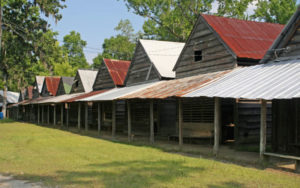 Few guesses came in for the most recent mystery photo thanks to (&#@!%&*!) technological travails related to an email address that was down for the week. That’s been fixed (thank goodness!), but many of you may be frustrated that your guess didn’t get to us.
Few guesses came in for the most recent mystery photo thanks to (&#@!%&*!) technological travails related to an email address that was down for the week. That’s been fixed (thank goodness!), but many of you may be frustrated that your guess didn’t get to us.
Several people guessed the photo to be Indian Land campground in Dorchester County while one diehard Carolina wag identified the buildings as Clemson dorms!
Nope. The photo is of the Cattle Creek Methodist Campground in Orangeburg County. Thanks to Bill Segars of Hartsville who allowed us to publish his photo. “The main giveaway is that the Indian Field tents are built in a circle,” Segars said. “Cattle Creek tents are built in a square. The structures look very similar.”
Hats off go to George Graf of Palmyra, Va., who correctly identified the photo. He noted, however, “Seems there are many of these places that are so similar. Tough to isolate the little differences to determine which is the matching answer. I’m not positive, but I’m going with this answer.”
- Send us a mystery: If you have a photo that you believe will stump readers, send it along (but make sure to tell us what it is because it may stump us too!) Send it along to editor@charlestoncurrents.com.
HISTORY: Ferries
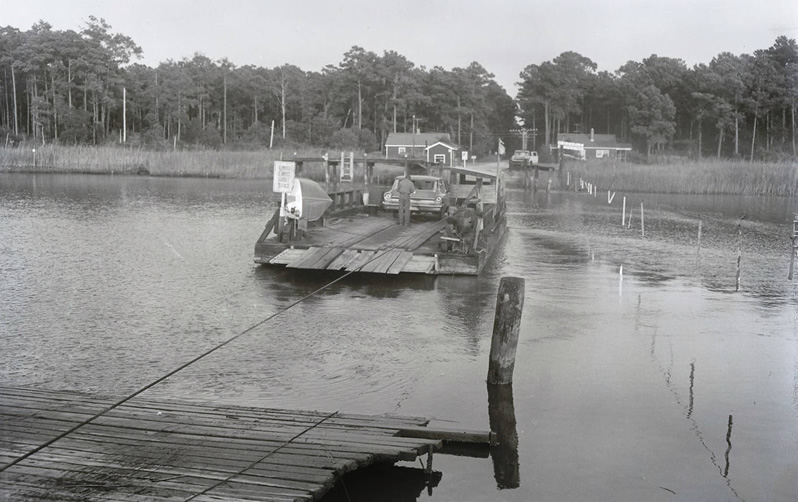
A hand-operated ferry in Georgetown County from years ago. (More)
S.C. Encyclopedia | The earliest ferries in South Carolina carried settlers across the Ashley, Cooper, Santee, and other Lowcountry waterways. Early ferries, sometimes called “boats” or “galleys,” were important for transportation but were frequently poorly constructed, haphazardly manned, and expensive to the everyday traveler. Accordingly, the General Assembly in 1709 passed the first of many laws governing the location, management, and fees associated with ferries. Under the law, the ferry master was to provide for the passage of one man at one pence and a “man and horse from one side of [the river] to the other” at a cost of two pence. Most ferries took the name of an early licensee: Mazyck, Skrine, Garner, Vance, Murry, or Nelson. Others were known only by the location: Strawberry Ferry, Ashley River Ferry, or South Island Ferry. One, across the Black River, was referred to only as the “Potato Ferry.”
The first boats were large canoes or flat-bottom scows that were powered by paddles, oars, or poles. Within one hundred years, flatboats capable of holding a wagon or carriage had become commonplace. The heavier load necessitated a pulley/winch system to move the flatboat and cargo against the current, and costs rose accordingly. In 1805 the toll on a team or carriage was $1.00, and a man and horse was 12.5¢. A barrel of freight was 25¢.
Ferry operations in antebellum South Carolina were closely regulated by the General Assembly, which established rates of toll and the duties of ferry operators. Negligent operators or those who attempted to extort higher tolls could be fined or have their ferry licenses taken away. The General Assembly could not, however, regulate nature. Floods, drought, and storms frequently interrupted ferry operations. Still, with bridges difficult to build and expensive, ferries were a vital link in the state’s transportation system throughout the eighteenth and much of the nineteenth centuries. Their number increased from several dozen crossings in 1775 to more than one hundred by 1825. As the state’s population spread inland in the early nineteenth century, ferries became increasingly prevalent in the backcountry.
The destruction or elimination of all but twenty ferries by 1865 was the beginning of the end for the institution. Steamboats and railroads lessened the need for ferries throughout the nineteenth century, while the arrival of the automobile finished it off in the twentieth century. Formed in 1917, the South Carolina Highway Department utilized taxes on automobiles, automobile dealerships, and gasoline to build the state’s first system of modern roads and bridges. With the assistance of federal money, South Carolina acquired thousands of miles of new roads and hundreds of bridges. A few ferries persisted until well into the twentieth century, such as Ashe’s Ferry at Van Wyck or Scott’s Ferry on the Savannah, but most were replaced by bridges. Places such as Givhans Ferry State Park in Dorchester County and Galivants Ferry in Horry County, however, provide reminders of the prevalence and importance of ferries in the state’s transportation history.
— Excerpted from an entry by Louis P. Towles. To read more about this or 2,000 other entries about South Carolina, check out The South Carolina Encyclopedia, published in 2006 by USC Press. (Information used by permission.)
ON THE CALENDARCALENDAR, June 4+: West Ashley improvement discussions, more
Staff reports | The Charleston Parks Conservancy and the City of Charleston are inviting the public share ideas to improve the West Ashley Greenway and Bikeway at a series of interactive design workshops from June 4 to June 7 in West Ashley.
The Conservancy and the city are creating a detailed master plan and design for a combined 10.5-mile stretch of the Greenway and Bikeway. This West Ashley Greenway and Bikeway Community Design Workshop is a chance for area residents to share their suggestions and have a say in shaping the future of these public spaces.
- Kickoff and Community Design Forum, June 4, 6:30 p.m. to 8:30 p.m. The Schoolhouse, Large Community Auditorium at 720 Magnolia Roadin West Ashley
- Open Studio, June 5 and June 6, 10 a.m. – 6:30 p.m.(drop in anytime). Charleston Parks Conservancy, Studio Space at 720 Magnolia Road, Suite 25, in West Ashley
- Work-in-Progress Presentation and Feedback Forum, June 7, 6:30 p.m. to 8:30 p.m.The Schoolhouse, Large Community Auditorium at 720 Magnolia Road in West Ashley
Also on the calendar:
Wooden Boat Show: 9 a.m. to 5 p.m., June 9, Battery Gadsden Cultural Center and National Park Service (follow the signs on Sullivan’s Island.) The second annual wooden boat exposition will highlight the region’s boating heritage. More.
Historic Charleston house tours. 10:30 a.m. to 12:30 p.m., every Tuesday through Aug. 7 at the Nathaniel Russel House, 51 Meeting St., Charleston, and every Thursday through Aug. 9 at the Aiken-Rhett House, 48 Elizabeth St. To learn more about the event and fees, click here.
Music Under the Oaks: 11 a.m. on July 7 and Aug. 4, Charles Pinckney National Historic Site, 1254 Long Point Road, Mount Pleasant. On June 2, NIA Productions will feature African drumming and dance; On July 4, the show will feature singer Ann Caldwell while the Plantation Singers will perform Aug. 4. Bring sunscreen and insect repellant.
Early morning bird walks at Caw Caw: 8:30 a.m. every Wednesday and Saturday, Caw Caw Interpretive Center, Ravenel. You can learn about habitats and birds, butterflies and other organisms in this two-hour session. Registration not required, but participants are to be 15 and up. $10 per person or free to Gold Pass holders. More: http://www.CharlestonCountyParks.com.
AREA FARMERS MARKETS
SATURDAYS: The Charleston Farmers Market, is back in action from 8 a.m. to 2 p.m. every Saturday through Nov. 24 at Marion Square. A holiday market will be open Dec. 1, 2, 8. 9, 15 and 16.
SATURDAYS: Johns Island Farmers Market operates each Saturday from 9:30 a.m. to 1:30 p.m. year-round with more than 50 local farmers and vendors, food trucks, music and more. The market is located on the campus of Charleston Collegiate School, 2024 Academy Road, Johns Island.
SATURDAYS: The Town Market on James Island are again open. Open 9 a.m. to 1 p.m. every Saturday at the James Island Youth Soccer Club, 871 Fort Johnson Road, James Island.
TUESDAYS: The Town of Mount Pleasant’s Farmers Market is every Tuesday from 3:30 p.m. to 7 p.m. in the market pavilion at Moultrie Middle School, 645 Coleman Blvd, in Mount Pleasant.
WEDNESDAYS. The West Ashley Farmers Market, 55 Sycamore Ave., is open every Wednesday from 3 p.m. to 7 p.m. in Ackerman Park. More.
THURSAYS. The Sullivan’s Island Farmers Market, 1921 I’On Avenue, is 2:30 p.m. to 6:30 p.m. through June 28.
- If you have an event to list on our calendar, please send it to charlestoncurrents@gmail.com for consideration. The calendar is updated weekly on Mondays.
OUR UNDERWRITERS
Charleston Currents is an underwriter-supported weekly online journal of good news about the Charleston area and Lowcountry of South Carolina.
- Meet our underwriters
- To learn more about how your organization or business can benefit, click here to contact us. Or give us a holler on the phone at: 843.670.3996.
OUR TEAM
Charleston Currents offers insightful community comment and good news on events each week. It cuts through the information clutter to offer the best of what’s happening locally.
- Mailing address: O. Box. 22261 | Charleston, SC 29413
- Phone: 670.3996
Charleston Currents is provided to you weekly by:
- Editor and publisher: Andy Brack, 843.670.3996
- Contributing photographer: Michael Kaynard
- Contributing editor, careers: Ben Fanning
- Contributing editor, common good, Fred Palm
- Contributing editor, money: Kyra Morris
- Contributing editor, Palmetto Poem: Marjory Wentworth
SUBSCRIBE FOR FREE
Subscriptions to Charleston Currents are free.
- Click here to subscribe.
- We don’t want to lose you as a reader of Charleston Currents, go to the bottom of any of your weekly newsletters and click the “unsubscribe” function. If that doesn’t work, please send us an email with the word “unsubscribe” in the subject line.
© 2008-2018, Statehouse Report, LLC. All rights reserved. Charleston Currents is published every Monday by Statehouse Report LLC, PO Box 22261, Charleston, SC 29413.




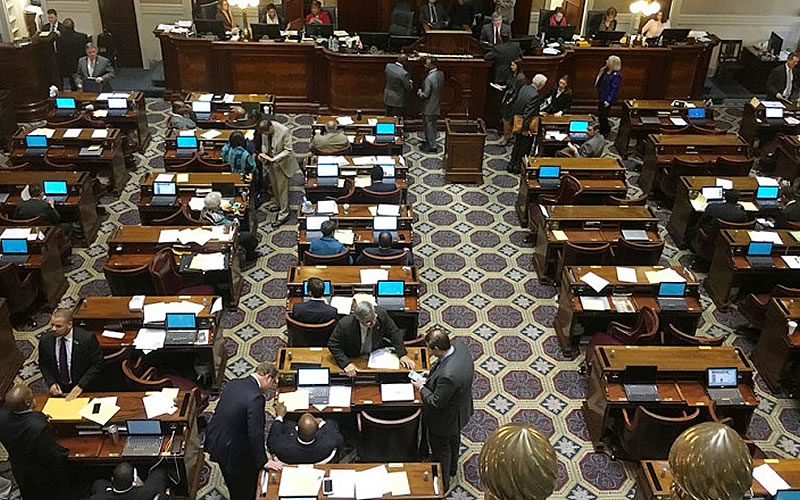
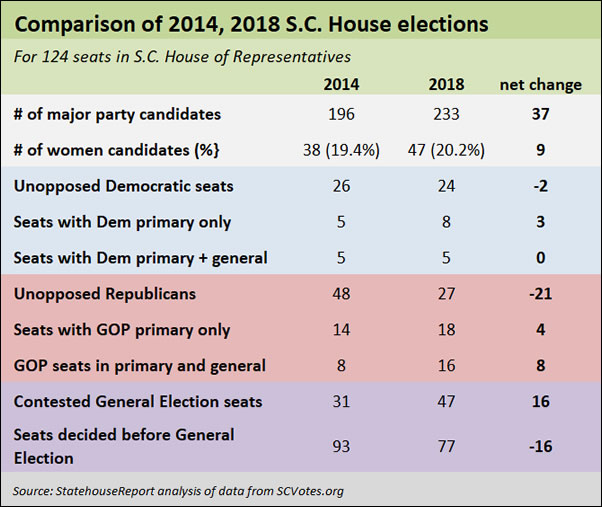
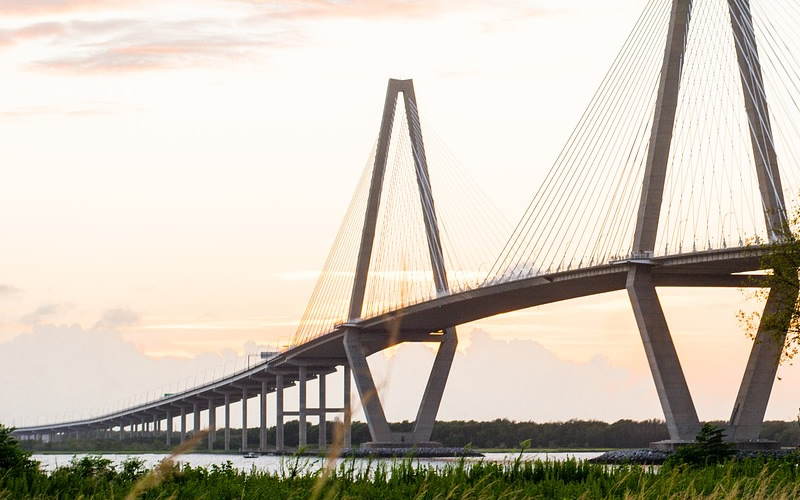
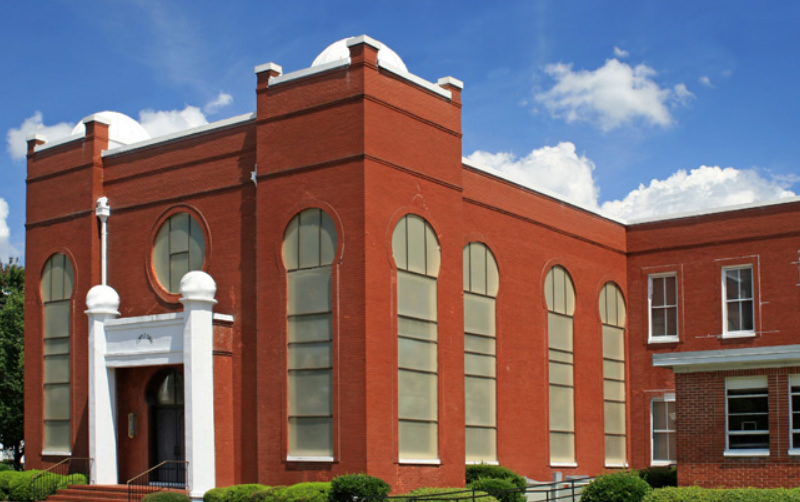

 We Can Do Better, South Carolina!
We Can Do Better, South Carolina!

























One Comment